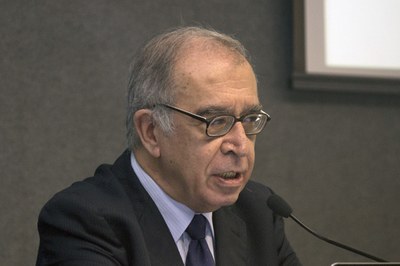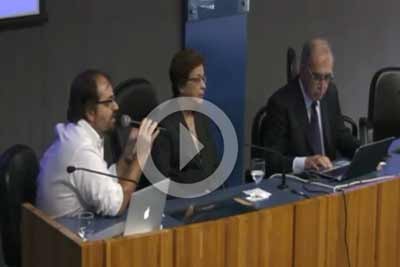Climate Time Scales and Climate Change
After humans began to recognize cycles and patterns in nature, the uncertainties of the future became less distressing, at least with regard to matters such as obtaining food and seeking shelter from inclement weather. But how should we react when the very future of life on our planet is at risk because one of the environmental variables has reached an unanticipated level?
According to astrogeophysicist Luiz Gylvan Meira Filho, former visiting professor and currently member of the IEA’s Environment and Society research group, humanity is entering a period when it is difficult to predict what might happen, “because in the last 800,000 years the concentration of atmospheric CO2 never exceeded 280 parts per million (ppm), and we have now reached 400 ppm.”
Meira Filho, who is one of Brazil’s leading experts on climate change and international climate negotiations, talked about the time scales of climate and of climate change in his conference at the Intercontinental Academia on April 22. For him, climate change should be seen in the context of time and treated as an urgent issue, “but not in the sense that something catastrophic may happen tomorrow or next week.”
During his exposition, he presented several graphs extracted from the 2014 Climate Change Synthesis Report prepared by the United Nations Intergovernmental Panel on Climate Change (IPCC).
CO2 Concentration
According to Meira Filho, the “proxy data” (data collected by paleoclimatologists from natural records of climate variations, e.g., stomata, phytoplankton and paleosoils) allow us to analyze the history of climate over a very long time. “In the very distant past, there have been concentrations of CO2 higher than the current 400 ppm. Three and half million years ago, it was 200 ppm and between that time and 800,000 years ago, CO2 concentration often reached 400 ppm.”
Related material |
|---|
However, when we observe a shorter period of time, up to 800,000 years ago, and also consider three astronomical variables that affect climate (orbital obliquity, orbital eccentricity and the precession of Earth’s axis), “we find that we are in a period when the concentration of atmospheric CO2 should reach a maximum of 280 ppm; it never reached 300 ppm in the last 800,000 years.”
It turns out that very recent history, as verified by measurements at the top of the Mauna Loa volcano in Hawaii, shows that CO2 concentration was 320 ppm in 1970 and reached 380 ppm in 2005. According to Meira Filho, measurements at Mauna Loa began in 1958 and, at that time, already exceeded the 280 ppm typical of the pre-industrial period. “Nowadays, we don’t need to read scientific journals; the daily newspapers tell us that levels have reached 400 ppm.”
“This increase was caused by man. It is relatively simple to measure and apply the scientific method to find that CO2 concentration is increasing. And, by analyzing several hypotheses, we can conclude that this is due to the burning of fossil fuels.” For Meira Filho, this conclusion is supported by the fact that there are no natural processes that burn fossil carbon in significant amounts. Even volcanic activity releases relatively small quantities of CO2.
The greenhouse effect
He explained how the greenhouse effect derives from excess CO2 in the atmosphere: “Our planet receives energy from the Sun and radiates part of it back into space in the form of infrared radiation, which acts as a cooling mechanism to maintain the thermal balance of the Earth’s surface. There has to be an equilibrium, otherwise the planet will heat up or cool down. CO2 absorbs infrared radiation, unbalancing the system and causing the greenhouse effect, which warms the surface of the Earth.”
According to him, climate is determined by the absorption of electromagnetic energy from the Sun in the visible spectrum. “This does not occur uniformly, because tropical regions receive more energy than the polar ones. This difference in energy deposition causes the movements of the atmosphere and the transfer of energy. The oceans are also involved in the process. This is how climate models and their dynamics came about.”
 From the point of view of science, the greatest dilemma has been the fact that climate change as reported in the newspapers cannot be observed: “In geophysics and astrophysics, we usually can’t apply the scientific method of laboratory experiments; things have to be done piecemeal. The beginning of this story has been solved, with the finding that the increase of atmospheric CO2 is due to emissions caused by man. The result, i.e., the impact on the climate, is harder to explain.”
From the point of view of science, the greatest dilemma has been the fact that climate change as reported in the newspapers cannot be observed: “In geophysics and astrophysics, we usually can’t apply the scientific method of laboratory experiments; things have to be done piecemeal. The beginning of this story has been solved, with the finding that the increase of atmospheric CO2 is due to emissions caused by man. The result, i.e., the impact on the climate, is harder to explain.”
Numerical models
What scientists have been doing for years is “to improve the numerical models so as to predict weather a posteriori, that is, to predict today how climate evolved over the last century.” This job requires increasingly powerful supercomputers. However, according to Meira Filho, the physics behind it is very simple and uses “well-known and very stable laws of conservation of mass, energy (first law of thermodynamics) and momentum (Newton’s law). They are written in the form of differential equations with respect to time; we take a numerical quantity at a certain point in time, integrate the variants numerically and find the value in the future.”
“These models have been significantly improved, to the point of being able to estimate rather accurately how climate evolved over the last 100 years vis-à-vis how it actually developed. Once this is simulated in a computer, we can easily change the procedures to take into account increased atmospheric concentration of greenhouse gases and see what happens.”
Future scenarios
The result is the realization that we must reduce the emission of greenhouse gases to control the rise in temperature. He showed graphs with four possible scenarios for 2100: 1) increase of 3.5 °C in the average temperature of the planet’s surface as early as 2100 and a trend of sharp increases in the following centuries if the emission of greenhouse gases continues to grow at the current rate; 2) increase of 0.5 °C if all emissions cease now; 3) increase of up to 2 °C (agreed at the UN Conference on Climate Change in December 2009 in Copenhagen), provided all countries concur to lower their emissions accordingly at the conference that the United Nations will hold in December in Paris; 4) increase of up to 3 °C if decisions adhere only to what was defined in Copenhagen.
According to Meira Filho, the climate system has essentially two memories: the first one has to do with the fact that greenhouse gases remain in the atmosphere for different periods (ten years for methane and more than 100 years for nitrous oxide; in the case of CO2, the decrease is related to the level of biological activity on the planet); the second memory concerns the slow warming movement of the oceans, governed by maritime currents, which are relatively slow.
The permanence of gases
The combination of these two memories leads the maximum effect on climate change of methane to take place 20 years after the emission, and of carbon dioxide and nitrous oxide, 40 to 50 years. “This means that if we want to stabilize temperature in 2100, we have to stabilize emissions by 2050 and this depends on the industries and the infrastructure that are being planned today. Hence the urgency of dealing with the problem.”
Meira Filho concluded with a warning based on another scientific methodology: “If we look at this scenario using the concept of phase space and if we place in the coordinates of a multidimensional space one of the important variables that describe the climate system over time, the conclusion we reach is that we have already entered a phase space that we have never occupied in the last 800,000 years. This is scary, to say the least. We are in uncharted territory and this brings risks to the continuity of life.”

